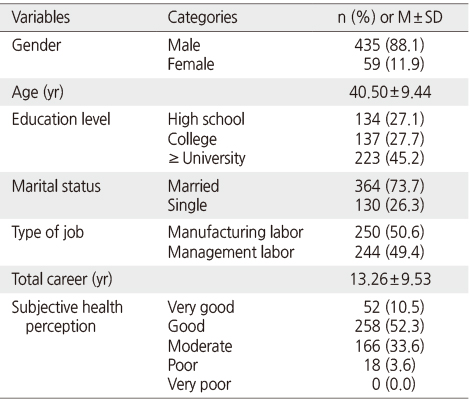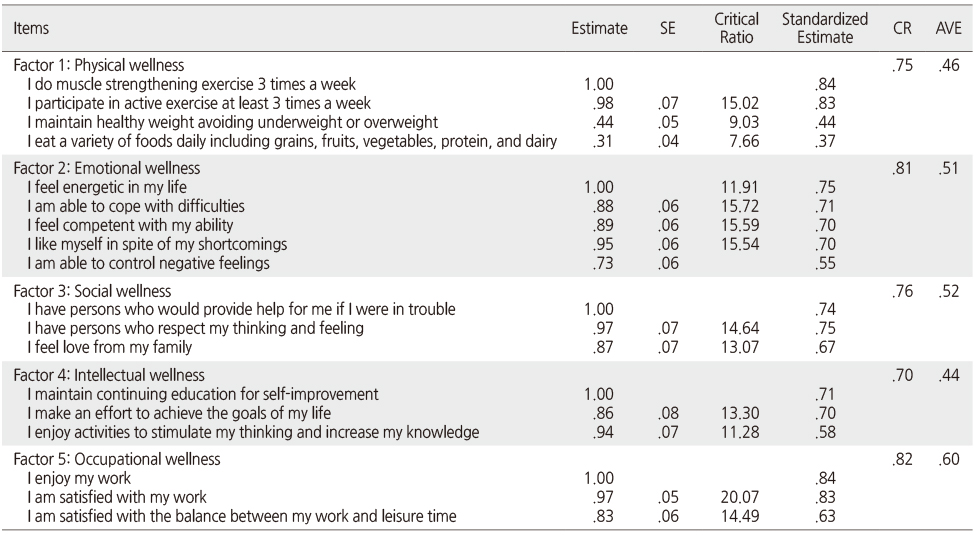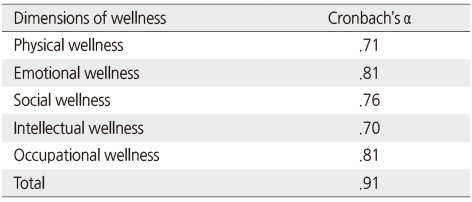Articles
- Page Path
- HOME > J Korean Acad Nurs > Volume 46(1); 2016 > Article
-
Original Article
- Development of a Wellness Index for Workers
- Moon-Jong Choi, Chang-Sik Son, Jinsu Kim, Yeongmi Ha
-
Journal of Korean Academy of Nursing 2016;46(1):69-78.
DOI: https://doi.org/10.4040/jkan.2016.46.1.69
Published online: February 29, 2016
1Medical Device Development Center, DGMIF, Daegu, Korea.
2Wellness Convergence Research Center, DGIST, Daegu, Korea.
3College of Business Administration, Gyeongsang National University, Jinju, Korea.
4College of Nursing·Institute of Health Sciences, Gyeongsang National University, Jinju, Korea.
- Address reprint requests to: Ha, Yeongmi. College of Nursing·Institute of Health Sciences, Gyeongsang National University, 816 beon-gil 15, Jinju-daero, Jinju 52727, Korea. Tel: +82-55-772-8253, Fax: +82-55-772-8222, yha@gnu.ac.kr
© 2016 Korean Society of Nursing Science
This is an Open Access article distributed under the terms of the Creative Commons Attribution NoDerivs License. (http://creativecommons.org/licenses/by-nd/4.0/) If the original work is properly cited and retained without any modification or reproduction, it can be used and re-distributed in any format and medium.
Abstract
-
Purpose
- The purpose of this study was to develop a wellness index for workers (WIW) and examine the validity and reliability of the WIW for assessing workers' wellness.
-
Methods
- The developmental process for the instrument included construction of a conceptual framework based on a wellness model, generation of initial items, verification of content validity, preliminary study, extraction of final items, and psychometric testing. Content validity was verified by 4 experts from occupational health nursing and wellness disciplines. The construct validity, convergent validity and discriminant validity were examined with confirmatory factor analysis. The reliability was examined with Cronbach's alpha. The participants were 494 workers from two workplaces.
-
Results
- Eighteen items were selected for the final scale, and the results of the confirmatory factor analysis supported a five-factor model of wellness with acceptable model fit, and factors named as physical · emotional · social · intellectual · occupational wellness. The convergent and discriminant validity were also supported. The Cronbach's alpha coefficient was .91.
-
Conclusion
- The results indicate that the WIW is a valid and reliable instrument to comprehensively assess workers' wellness, and to provide basic directions for developing workplace wellness program.
This work was supported by the R&D Program of the Ministry of Trade, Industry and Energy of Korea (Program of Advanced Technology Development for Future Industry, 10044353).
The authors declared no conflict of interest.
- 1. Dunn HL. High level wellness. Thorofare, NJ: Charles B. Slack; 1977.
- 2. Larson JS. The conceptualization of health. Med Care Res Rev. 1999;56(2):123–136. ArticlePubMedPDF
- 3. Smith BJ, Tang KC, Nutbeam D. WHO health promotion glossary: New terms. Health Promot Int. 2006;21(4):340–345. ArticlePubMed
- 4. Office of Strategic R & D Planning, Korea Institute of Industrial Technology. 2012 trends analysis and future strategies of wellness industry. Cheonan: Korea Institute of Industrial Technology; 2012.
- 5. Roscoe LJ. Wellness: A review of theory and measurement for counselors. J Couns Dev. 2009;87(2):216–226. Article
- 6. World Economic Forum. The workplace wellness alliance - making the right investment: Employee health and the power of metrics [Internet]. Geneva, CH, Author. 2013;cited 2015 January 10. Available from: http://www3.weforum.org/docs/WEF_HE_WorkplaceWellnessAlliance_Report_2013.pdf
- 7. Doyle EI, Ward SE, Oomen-Early J. The process of community health education and promotion. 2nd ed. Long Grove, IL: Waveland Press; 2010.
- 8. Centers for Disease Control and Prevention. National healthy worksite program [Internet]. Atlanta, GA, Author. 2014;cited 2015 January 10. Available from: http://www.cdc.gov/nationalhealthyworksite/index.html
- 9. Ministry of Health and Welfare. National health plan 2020. Seoul: Author; 2011.
- 10. Baicker K, Cutler D, Song Z. Workplace wellness programs can generate savings. Health Aff (Millwood). 2010;29(2):304–311. ArticlePubMed
- 11. Hettler B. Wellness promotion on a university campus. Fam Community Health. 1980;3(1):77–95.ArticlePubMed
- 12. Travis JW, Ryan RS. Wellness workbook. 3rd ed. Berkeley, CA: Ten Speed Press; 2004.
- 13. Harrington D. Confirmatory factor analysis. New York, NY: Oxford University Press; 2009.
- 14. Korea Ministry of Government Legislation. Labor standards act [Internet]. Sejong, Author. 2015;cited 2015 July 6. Available from: http://www.law.go.kr/lsInfoP.do?lsiSeq=150421&efYd=20140701#0000
- 15. National Institute of Korean Language. Basic Korean dictionary [Internet]. Seoul, Author. 2015;cited 2015 July 6. Available from: http://stdweb2.korean.go.kr/search/View.jsp
- 16. Myers JE, Sweeney TJ. The indivisible self: An evidence-based model of wellness. J Individ Psychol. 2004;60(3):234–245.
- 17. Sweeney TJ, Witmer JM. Beyond social interest: Striving toward optimum health and wellness. Individ Psychol. 1991;47(4):527–540.
- 18. Depken D. Wellness through the lens of gender: A paradigm shift. Wellness Perspect. 1994;10(2):54–69.
- 19. Adams T, Bezner J, Steinhardt M. The conceptualization and measurement of perceived wellness: Integrating balance across and within dimensions. Am J Health Promot. 1997;11(3):208–218. ArticlePubMedPDF
- 20. Renger RF, Midyett SJ, Soto Mas FG, Erin TD, McDermott HM, Papenfuss RL, et al. Optimal living profile: An inventory to assess health and wellness. Am J Health Behav. 2000;24(6):403–412. Article
- 21. Hair JF Jr, Black WC, Babin BJ, Anderson RE. Multivariate data analysis. 7th ed. Upper Saddle River, NJ: Pearson Prentice-Hall; 2010.
- 22. Ware JE Jr, Gandek B. Methods for testing data quality, scaling assumptions, and reliability: The IQOLA project approach. J Clin Epidemiol. 1998;51(11):945–952. PubMed
- 23. Schumacker RE, Lomax RG. A beginner's guide to structural equation modeling. 3rd ed. New York, NY: Routledge; 2010.
- 24. Lee K, Shin S. Validity of instrument development research in Korean nursing research. J Korean Acad Nurs. 2013;43(6):697–703. ArticlePubMed
- 25. Bae BR. Structural equation modeling with Amos 19: Principles and practice. Seoul: Chungram Books; 2011.
- 26. Hattie JA, Myers JE, Sweeney TJ. A factor structure of wellness: Theory, assessment, analysis, and practice. J Couns Dev. 2004;82(3):354–364. Article
- 27. Dahlgren G, Whitehead M. European strategies for tackling social inequities in health: Levelling up part 2. Copenhagen, DK: World Health Organization Regional Office for Europe; 2006.
- 28. Ministry of Employment and Labor. Campaign for balance of work and life [Internet]. Sejong, Author. 2014;cited 2015 January 10. Available from: http://www.worklifebalance.co.kr/campaign/
- 29. Nunally JC. Psychometric theory. 2nd ed. New York, NY: McGraw-Hill; 1978.
- 30. Strout K. Wellness promotion and the institute of medicine's future of nursing report: Are nurses ready? Holist Nurs Pract. 2012;26(3):129–136. PubMed
REFERENCES
Figure & Data
REFERENCES
Citations

- The Mediating Effect of Self-Transcendence on the Relationship between Job Stress and Wellness among Nurses
Sung Mi Kim, Da Eun Kim
Journal of Korean Academy of Nursing Administration.2025; 31(4): 394. CrossRef - Tourists' perceived value and behavioral intentions based on the choice attributes of wellness tourism
Miseong Kim, Hyunji Moon, Yeonwoo Joo, Yooshik Yoon
International Journal of Tourism Research.2024;[Epub] CrossRef - The Influence of Wellness on Job Satisfaction among Police Officers: Focused on the Mediating Effect of the Meaning in Work
Soolgi Han, Kyonghwa Kang
Journal of Korean Academy of psychiatric and Mental Health Nursing.2024; 33(1): 18. CrossRef - Effectiveness of End-of-Life Care Debriefing for Intensive Care Unit Nurses
Sook Hyun Park, Jung Eun Lee, Yu-Jin Jung, Ha Neul Yoo, Yeon Su Kim, Young Hee Yi
Journal of Korean Critical Care Nursing.2024; 17(3): 87. CrossRef - Development and effectiveness of a cognitive enhancement program based on a mobile application for preventing dementia: a study focusing on older adults who use senior citizen centers
Mi-Ra Jung, Eun Jeong, Chang-Gyeong Lee
Journal of Korean Biological Nursing Science.2023; 25(2): 113. CrossRef - Effectiveness of a Mobile Wellness Program for Nurses with Rotating Shifts during COVID-19 Pandemic: A Pilot Cluster-Randomized Trial
Yeongmi Ha, Sang-Ho Lee, Dong-Ha Lee, Young-Hun Kang, Woonjoo Choi, Jinung An
International Journal of Environmental Research and Public Health.2022; 19(2): 1014. CrossRef - Factors Influencing the Wellness of Call Center Employees
Yeonju Kim, Gwang Suk Kim, Youlim Kim
Journal of Korean Academy of Community Health Nursing.2022; 33(1): 128. CrossRef - Development and Effectiveness of a Community Capacity Building Program for the Wellness of Traditional Marketplace Merchants: A Pilot Study
Yeojoo Chae, Yeongmi Ha
International Journal of Environmental Research and Public Health.2021; 18(22): 12238. CrossRef - Impact of Mental Health on Wellness in Adult Workers
Won Ju Hwang, Hyun Hee Jo
Frontiers in Public Health.2021;[Epub] CrossRef - The Moderating Effect of Nursing Practice Environment on the Relationship between Clinical Nurses’ Sleep Quality and Wellness
Kyung Jin Hong, Youngjin Lee
International Journal of Environmental Research and Public Health.2020; 17(19): 7068. CrossRef - Effectiveness of a Workplace Walking Program Using a Fitness Tracker Including Individual Counseling and Tailored Text Messaging
Mira Jung, Yeongmi Ha
Journal of Korean Academy of Community Health Nursing.2019; 30(3): 257. CrossRef - The Effects of a Mobile Wellness Intervention with Fitbit Use and Goal Setting for Workers
Sang-Ho Lee, Yeongmi Ha, Mira Jung, Seungkyoung Yang, Won-Seok Kang
Telemedicine and e-Health.2019; 25(11): 1115. CrossRef - Wellness and sleep quality in Korean nursing students: A cross-sectional study
Sunghee Park, Youngjin Lee, Moonsook Yoo, Sunyoung Jung
Applied Nursing Research.2019; 48: 13. CrossRef - The Relationship between Quality of Sleep, Job Commitment and Wellness of Night Shift Nurses in Medium and Small-sized Hospitals
Yeojoo Chae, Youngshim Go, Jia Kim, Chaecyeung Jeong, Minhui Lee, Yeongmi Ha
Journal of Health Informatics and Statistics.2017; 42(4): 330. CrossRef
General Characteristics of Participants (N =494)
Goodness of Fit Indices for Wellness Index using Confirmatory Factor Analysis
CMIN/DF=Chi-square minimum/degree of freedom; GFI=Goodness of fit index; NFI=Normal fit index; CFI=Comparative fit index; TLI=Turker-Lewis index; RMSEA=Root mean square error of approximation.
Confirmatory Factor Analysis and Final Items for WIW
AVE=Average variance extracted; CR=Composite reliability; WIW=Wellness index for workers.
Correlations between the Five Dimensions of Wellness
AVE=Average variance extracted.
Reliability of Five Dimensions of Wellness
CMIN/DF=Chi-square minimum/degree of freedom; GFI=Goodness of fit index; NFI=Normal fit index; CFI=Comparative fit index; TLI=Turker-Lewis index; RMSEA=Root mean square error of approximation.
AVE=Average variance extracted; CR=Composite reliability; WIW=Wellness index for workers.
AVE=Average variance extracted.
 KSNS
KSNS
 E-SUBMISSION
E-SUBMISSION





 Cite
Cite

